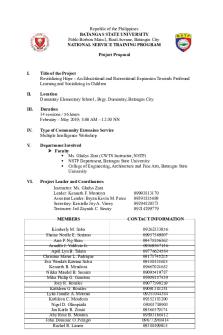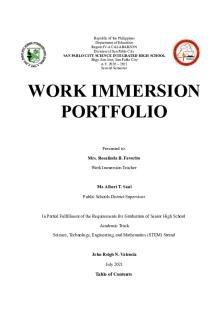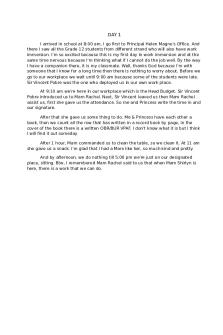Cultural Immersion Project 2 PDF

| Title | Cultural Immersion Project 2 |
|---|---|
| Author | Cara Soto |
| Course | Multicultural Counseling |
| Institution | Liberty University |
| Pages | 9 |
| File Size | 124.1 KB |
| File Type | |
| Total Downloads | 102 |
| Total Views | 155 |
Summary
Benchmark Assignment...
Description
CULTURAL IMMERSION PROJECT 2
1
Cultural Immersion Project 2 Cara Soto Liberty University
What events did you watch? What happened? The two events that I choose to watch are deeply rooted in the Haitian culture and heritage. The first event that I chose was a documentary on the Haitian revolution. Haiti was the first slave holding country to win their independence. Before the independence of the slaves on the island of Haiti, it was a French colony. It was one of the richest in the Americas, with sugar and coffee being the main export. When the revolution started there were 40,000 white and mulatto on the island and 30,000 slaves. The slaves revolted against their masters and won their freedom. Toussaint Louverture was a slave that helped lead the country to freedom. It was not a short war, it took 12 long and bloody years to gain their freedom from France. Their Independence Day January 1, 1804 coincides with New Year’s Day and is celebrated by great festivities and a special soup made from pumpkin that is shared with neighbors and visitors alike (PBS Documentary, 2017) The second video I watched was about the main religion in Haiti which is Voodoo. Voodoo is a mixture of Ancient African ancestor worship and Catholicism. Before each ceremony it is customary to say a catholic prayer and cross one’s self. Ceremonies consist of dances with the use of rhythmic drums to call spirits to possess its dancers. There is a family of spirits called the Lua. Each Voodoo worshiper is assigned their own spirit and can marry that spirit. To appease these spirits sacrifices of goats, chickens and pigs are made. With offerings of food and rum. These ceremonies are to appease the spirits and word off sicknesses and bring prosperity (Atlantas, 2013). How did your experience of actual cultural events compare with the expectations you had developed from the readings and Internet/media explorations you did in Cultural Immersion Project – Part 1?
As I interviewed one of the ladies for the project, I did not anticipate the compassion that I would feel from hearing her story. At the first of the interview she told me how Voodoo affects the lives of Christians in Haiti and she told me what she knew about the religion. As the interview went on she became incredibly open with me about the death of her younger brother and how a Voodoo curse had played a part in his death. I expected her to be more closed with her feelings due to the information I had read in the journals. However, as she cried recounting the story of her little brother, I cried too. The last half of the interview was very emotional for me. Another interview that I did with an American-Haitian lady, for the discussion of the Haitian revolution, was a comment that she made that I had only heard from white Americans, and it was that she thought Haitians were in the situation they were in because they had given their land (Haiti) to the devil by the practice of Voodoo. I did not expect to hear that from and Haitian and I wonder if it is because she is American Haitian and has the American mindset. Looking back at the interview, I wish I would have explored this concept more with her. How did participation in these immersion events impact you emotionally? In other words, what was it like to be a minority in this group? As I watched the video on the revolution it made me angry because when the revolution started the whites turned the event and made it seem that they were the victims. It is so frustrating to see the injustice that happens between races. As a white American woman who was listening and observing the events that happened and continue to repeat, it is infuriating how we as whites (and some other races) close our eyes and do not educate ourselves to the truth. As I tell people what I’m finding out about the country of Haiti and how it is the poorest, they have the audacity to say that Haiti and it’s people are in that situation because they sold their souls to the devil when the revolution happened. It is true that voodoo ceremonies were performed the
night that the revolution started, however can we recognize that there was an embargo for 60 years on Haiti. They were not allowed to buy or sell with the United states or Europe. And then France made Haiti pay for their freedom with a hefty 150 million francs (21 billion in today’s dollars), France made them pay for the loss of slaves and plantations. What!?! To me this is just unbelievable. So not only do the French, Spanish and other whites Europeans intrude on the island killing off and enslaving the native Taino Arawak, they kidnap and import hundreds of thousands of slaves. And they claim to be the ones with the losses. By claiming that Haiti is in the situation it is because of the Voodoo ceremony used to gain freedom, seems to me that we are shifting the blame of their suffering back on them and relieving ourselves of the compassion and responsibility that we are accountable for as fellow humans. As you consider your own cultural background, why do you think you responded the way you did? I think I responded the way I did with anger and disbelief because not only does my culture (I’m not saying all whites, but the majority) choose to ignore and admit the wrongs we have committed, but we continue to be the perpetrators in many ways. Such as not acknowledging the systematic racism that occurs here in the United States. Or the fact that we are taking the land from Haitians here in Miami so that the rich can have higher ground and this leaves the struggling to continue to struggle even more (Moony, 2020). White race choosing to only listen to one side and not be educated in both is a complete disregard of humanity. Is the shame to great for us to admit? Is it because we like the comforts that our ignorance brings? Growing up I heard many racist comments from my grandmother, great-grandmother and my father. The mindset is so narrow when we choose to degrade another based on their skin color. I remember my boyfriend at the time, now my husband, came to my house for a visit. My
grandmother called to me and said, Cara, that monkey is here to see you again”. I have spent years correcting the terms and inaccurate ideas of my family of origin. My father is the one who has had the most significant change of heart. He has educated himself on many different social issues. If I had not married interracially, I do not believe I would have been made aware and formed a different perspective on race and the struggles that come with being a minority. What are some key things that you have learned about this culture through these events? I believe the key things that I have learned about this culture is how unjustly they have been treated. From the time that the African’s were kidnapped and forced from their country and put on ships to become slaves onto the present-day unjustness, these beautiful people have never been given a chance to progress and make a better change for their country or themselves. Here are some key positives that I have learned about the Haitian people. They are resilient, hardworking, fun-loving, caring and sharing people, who value their families and want the best for their children. For example, I want to refer to Independence Day celebration. It is tradition where they cook a squash soup and give it to neighbors and strangers. They also pronounce well wishes on everyone they meet. They stay up all night singing, telling stories and eating (Brice International. 2020). I see a people that despite what they have been through still smiling, still celebrating, still wishing others well. Furthermore, I learned that voodoo is what united the many different cultures of the African people as they came to a new land. Voodoo plays a big part in the life of all Haitians (Guynup, 2004). Christian and non-Christian. For the Christian in Haiti they recognize that Christ is more powerful than the evil spirits that are worshiped in Voodoo. One of my interviewees said that she saw demons being cast out of a man while he was in church worshiping God. The spirits took control of him and flung him to the floor. The others in church
gathered around him and started praying. The spirit finally left, however, for the Christian in Haiti she said that there is no playing in the middle. You have to choose a side. Either you are a Christian or you are not. Discuss counseling theories and techniques that have been empirically validated as effective with this group. Three theoretical approaches: Haitians have lived under tremendous stress whether in their country or in the US. Due to these natural disasters that have occurred in recent years, many Haitians have come to the US seeking refuge. In the US refugees face discrimination, and hardship of a different kind then in their home country. Shillingford et al. (2018) suggests that the use of constructionist theory, which focuses on how cultural influences and interpretation shape meaning in the life of their client, can be a benefit. She also suggests systematic and creative therapy should be incorporated with spiritual and cultural values of Haitian clients. Three counseling techniques: McGoldrick et al. (2005), suggest the use of questions to help uncover the trauma which do not always correlate to the client’s symptoms. When counseling a Haitian client, the counselor must take into consideration not only the traumatic events that have occurred in their client’s life but also understand the cultural dynamics. The family system is an integral part of the Haitian life. This multi-generational network of family members, some who are refered to an auntie or uncle, even if they are not blood related, is the base of the support system (Nicholas, et al. 2008). In the evening after chores are done, parents, children and extended family gather around in the lakou (a space in the back yard) to tell stories, here metaphors are commonly used to express feelings, give instruction on life directions or just for entertainment. This form of interacting with family carries over into the counseling setting. It has been found that when counseling a client that the use of metaphors and stories helps a client
be more willing to open up and feel more comfortable with the counselor because they can relate to what is being illustrated. (Rahill, 2011). Group therapy has also proved beneficial as well as the use of dance, song and working with spiritual healers (Shillingford et al. 2018). McGoldrick et. al. (2005) also noted that Haitians are slow to seek counseling unless there is some practical benefit to it. Counselors should be aware of this and incorporate outside agencies and practical resources to help encourage the client see the benefits of counseling. Resilience is an underlying strength of the Haitian people. They metaphorically refer to themselves as bamboo and use a popular saying to reinforce the image by saying, “Pliye, pliye, pa kase.” Translated as “Bend (Fold), bend, don’t break.” (Rahill, et. al., 2016). When a client obtains help from a counselor whether it be for interpersonal issues, school issues or practical help, the clients benefit by gaining not only tangible help such as tutoring for children, English classes for parents, financial support for child care, they also benefit from emotional and mental growth facilitated by the counselors listening ear and words of encouragement. For example, a Haitian man had come to counseling after being referred by an attorney for evaluation of Posttraumatic stress disorder (PTSD). The counselor who was Haitian themself, used metaphors to help the client open up about his feelings. After a few weeks the client in return gave this metaphor of the new feelings and perspective he now had. He said that he had felt like he was locked up in a tiny room with no air, suffocating. He said the counselor opened the door to let him breath again. The client went on to overcome the obstacle that was causing him stress and anxiety (Rahill et. al. 2011).
Reference Atlantas, N. (2013, November 6). Voodoo. Retrieved from https://www.youtube.com/watch? v=gtKpkm7xYi8 Brice International. (2020, September 19). Retrieved from Brice Foundation International: https://www.bricefoundation.org/haitian-culture-and-tradition Culture Crossing. (2017). Haiti. Retrieved from Cultural Crossing Guide: https://guide.culturecrossing.net/basics_business_student_details.php?Id=19&CID=90 Guynup, S. (2004, July 7). Haiti: Possessed by Voodoo. Retrieved from National Geographic: https://www.nationalgeographic.com/news/2004/7/haiti-ancient-traditions-voodoo/ McGoldrick, M. G.-P. (2005). Ethnicity anf Family Therapy. New York: The Guilford Press. Mooney, T. (2020, March 23). Little Haiti residents forced from home again as climate change upends Miami real estate. Retrieved from CBS News: https://www.cbsnews.com/news/climate-change-miami-little-haiti-gentrification-cbsnoriginals-documentary/ Nicholas Tekla, A. S. (2008). "Here's Your Diploma, Mom!" Family Obligation and Multiple Pathways to Success. The Annals of the American Acadamy of Political and Social Science, 237-252. PBS Documentary, (2017, February 3). Egalite for All: Toussaint Louverture & The Haitian Revolution. Retrieved from https://www.youtube.com/watch?v=Sn32cWUT83E Rahill, G. J., Ganapati, N. E., Joshi, M., Bristol, B., Molé, A., Jean-Pierre, A., . . . Benavides, M. (2016). In their own words: Resilience among Haitian survivors of the 2010
earthquake. Journal of Health Care for the Poor and Underserved, 27(2), 580-603. doi:10.1353/hpu.2016.0100 Rahill Guitele, M. J.-G.-L. (2011). Metaphores as Contextual Evidence for Engaging Haitian Clients in Practice: A Case Study. American Journal of Psychotherapy, Vol. 65, Iss. 2 133-49. Shillingford, M. A., Oh, S., & DiLorenzo, A. (2018). Using the multiphase model of psychotherapy, school counseling, human rights, and social justice to support Haitian immigrant students. The Professional Counselor, 8(3), 240-248. doi:http://dx.doi.org.ezproxy.liberty.edu/10.15241/mas.8.3.240...
Similar Free PDFs

Cultural Immersion Project 2
- 9 Pages

Cultural Immersion Paper
- 5 Pages

Cultural Studies Task 2
- 3 Pages

CWTS Immersion Proposal
- 13 Pages

What is Community Immersion
- 3 Pages

Valencia-Immersion-Portfolio
- 56 Pages

Work Immersion Journal
- 8 Pages

SHS Work Immersion Portfolio
- 47 Pages

WORK IMMERSION ORIENTATION
- 23 Pages

Project 2
- 4 Pages

Project 2
- 21 Pages

Project 2
- 16 Pages
Popular Institutions
- Tinajero National High School - Annex
- Politeknik Caltex Riau
- Yokohama City University
- SGT University
- University of Al-Qadisiyah
- Divine Word College of Vigan
- Techniek College Rotterdam
- Universidade de Santiago
- Universiti Teknologi MARA Cawangan Johor Kampus Pasir Gudang
- Poltekkes Kemenkes Yogyakarta
- Baguio City National High School
- Colegio san marcos
- preparatoria uno
- Centro de Bachillerato Tecnológico Industrial y de Servicios No. 107
- Dalian Maritime University
- Quang Trung Secondary School
- Colegio Tecnológico en Informática
- Corporación Regional de Educación Superior
- Grupo CEDVA
- Dar Al Uloom University
- Centro de Estudios Preuniversitarios de la Universidad Nacional de Ingeniería
- 上智大学
- Aakash International School, Nuna Majara
- San Felipe Neri Catholic School
- Kang Chiao International School - New Taipei City
- Misamis Occidental National High School
- Institución Educativa Escuela Normal Juan Ladrilleros
- Kolehiyo ng Pantukan
- Batanes State College
- Instituto Continental
- Sekolah Menengah Kejuruan Kesehatan Kaltara (Tarakan)
- Colegio de La Inmaculada Concepcion - Cebu



